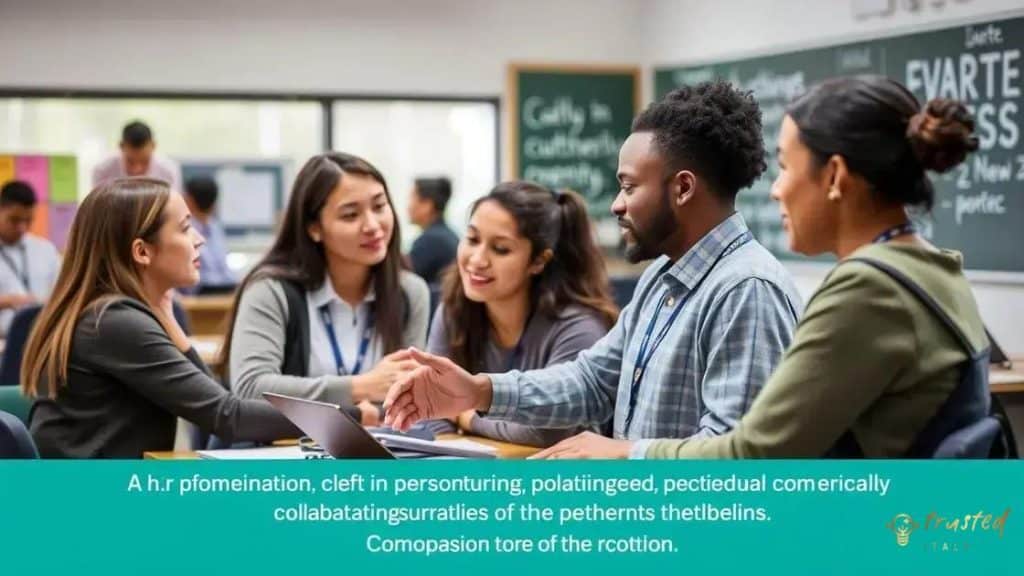Public-private partnerships to improve higher education funding

Public-private partnerships to improve higher education funding provide essential resources and innovative solutions, allowing institutions to diversify funding models and enhance educational quality and accessibility.
Public-private partnerships to improve higher education funding are becoming increasingly vital in today’s educational landscape. Have you ever wondered how these collaborations can enhance the resources available to students and institutions alike? In this article, we’ll explore the dynamic ways these partnerships are making a difference.
Understanding public-private partnerships
Understanding public-private partnerships is crucial in today’s education sector. These collaborations between government entities and private organizations can create innovative solutions for funding. By working together, they can enhance resources and drive improvements in higher education.
Public-private partnerships (PPPs) form a unique bridge between sectors. They allow for shared risks and rewards, benefiting both the institutions and the investors involved. But what does this really mean for education?
Key Characteristics of PPPs
PPPs in education often have some common features that set them apart:
- Shared resources: Both sectors contribute assets, be it funding, facilities, or expertise.
- Risk-sharing: Risks associated with projects are distributed between the parties, minimizing individual burdens.
- Public value: The main focus of these partnerships is to enhance public education, improving accessibility and quality.
Collaboration opens doors for many educational institutions. For instance, they might gain access to advanced technology and infrastructure that would be difficult to fund solely through public means. Additionally, private companies can leverage their expertise to foster innovation.
Impact on Funding
Through PPPs, educational institutions can receive financial support that is not available from traditional funding sources. This support can lead to:
- Enhanced facilities: Upgrading classrooms and laboratories is often easier with combined funds.
- Increased enrollment: More resources can attract students who would otherwise seek education elsewhere.
- Long-term sustainability: These partnerships can establish a continuous flow of resources to support ongoing educational needs.
In summary, understanding public-private partnerships reveals their vital role in revolutionizing funding for higher education. As these collaborations expand, they offer significant potential to improve educational outcomes for students and institutions alike. Challenges may arise, but the groundwork laid by these partnerships paves the way for innovation and resourcefulness in education.
Benefits for higher education

The benefits for higher education from public-private partnerships (PPPs) are significant and far-reaching. These collaborations not only boost funding but also enhance overall educational quality. Exploration of the advantages reveals how these partnerships can reshape institutions and student experiences.
One major benefit is the increase in available resources. With the involvement of private entities, universities can access additional funds that can be allocated for various initiatives. This allows for improvement in facilities and technologies, making learning environments more effective.
Enhanced Educational Resources
Public-private partnerships often lead to improved access to advanced resources:
- State-of-the-art technology: Institutions can invest in the latest tools and equipment to improve student learning.
- Facilities upgrades: With additional funds, schools can renovate buildings and libraries to create more inviting spaces.
- Innovative programs: PPPs provide the means to develop new degrees and courses that meet market demands.
These enhanced resources make institutions more competitive and appealing to prospective students. This appeal can lead to higher enrollment numbers, benefiting the institution financially. Additionally, a diverse student body often enhances the overall learning experience.
Improved Student Services
Another key benefit is the improvement in student services. PPPs can lead to:
- Career services: Private partners can provide job placements and internships, giving students real-world experience.
- Advising and mentoring: Collaborations often involve professionals who can guide students in their academic and career paths.
- Financial support: More scholarship opportunities can be made available through partnerships.
These improvements not only support students during their studies but also enhance their overall success after graduation. When students feel supported, they are more likely to thrive academically and professionally.
Furthermore, the collaboration of different sectors fosters an environment that encourages innovation. Educational institutions working with businesses are more likely to develop cutting-edge programs. This innovation is essential in keeping curricula relevant to today’s job market.
Successful case studies
Exploring successful case studies of public-private partnerships in higher education reveals valuable insights. These real-world examples showcase the potential of combined efforts and the positive impact on educational institutions.
One notable case is the collaboration between private technology firms and public universities. Through this partnership, universities gained access to cutting-edge technology, which greatly enhanced their computer science programs. This collaboration allowed students to work with the latest tools, preparing them for careers in a rapidly evolving job market.
Case Study 1: Community College Innovations
In another example, a community college partnered with local businesses to create specialized training programs. The results were impressive:
- Increased enrollment: The college saw a surge in applications as these programs attracted students looking for job-specific skills.
- Job placements: Graduates benefited from direct connections to employers, leading to higher employment rates.
- Funding boosts: Local businesses contributed to funding, which allowed for program expansion.
This partnership not only enhanced the college’s offerings but also addressed local workforce needs effectively. The business community appreciated the skilled graduates entering the workforce.
Case Study 2: University Research Initiatives
Another successful example involves a university teaming up with private research firms. This collaboration focused on renewable energy technology:
- Joint research projects: The partnership facilitated research projects that provided students real-world experience.
- Grant funding: Together, they secured grants that funded advanced research facilities.
- Innovation incubation: The partnership fostered an environment where new energy solutions could be developed.
Students gained hands-on experience in research, enhancing their education while contributing to significant advancements in technology. Such initiatives demonstrate the real-world impact of successful collaborations.
These case studies highlight how public-private partnerships can lead to innovative solutions in education. They showcase the immense potential of collaborating with private entities to enhance educational programs and services.
Challenges and considerations

When exploring challenges and considerations in public-private partnerships for higher education, it’s essential to recognize the complexities involved. While these collaborations come with numerous benefits, they also present specific hurdles that need to be addressed for success.
One major challenge is aligning goals between public institutions and private partners. Each party may have different priorities, which can lead to misunderstandings. It’s crucial for both sides to communicate openly and find common ground to work from. Without this, the partnership can falter.
Financial Risks
Another consideration is the potential for financial risks. These partnerships often involve significant investment from private entities:
- Investment uncertainty: Private companies may face challenges in seeing a return on their investment, leading to hesitance in funding.
- Budget constraints: Public institutions may struggle to meet their financial obligations, placing added stress on the partnership.
- Funding dependency: Over-reliance on private funding can create instability if the partnership dissolves.
Managing these financial risks requires strategic planning and thorough analysis. It’s imperative for institutions to have a clear financial framework to guide the partnership.
Regulatory and Compliance Issues
Another factor to consider is the regulatory and compliance landscape. Higher education is subject to numerous regulations that can complicate partnerships:
- Compliance burdens: Public institutions must adhere to government regulations, which may limit their ability to innovate.
- Liability concerns: Partnerships could create liability issues, as responsibilities must be clearly defined.
- Transparency requirements: Public-private partnerships often require more transparency, which can slow decision-making processes.
Addressing these concerns involves staying informed about relevant laws and regulations. Collaboration with legal experts can help institutions navigate this complex terrain efficiently.
Additionally, stakeholder engagement is critical. Universities must involve faculty, staff, and students in discussions about partnerships. This inclusivity fosters a sense of community and helps address any concerns before they escalate.
The future of funding in higher education
The future of funding in higher education is evolving rapidly. As universities face new challenges, they must adapt to changing financial landscapes. Public-private partnerships (PPPs) are becoming increasingly relevant in this scenario.
One significant trend is the increasing reliance on diversified funding sources. Educational institutions no longer depend solely on tuition fees and government funding. Instead, they are exploring various options, such as donations, grants, and partnerships with private companies. This diversification can help stabilize funding and promote long-term growth.
Emergence of Innovative Funding Models
Innovative funding models are also on the rise. These include:
- Equity funding: Some universities are now considering equity investment models where private companies invest in education and receive a part of future revenues.
- Income share agreements: This model allows students to receive funding for their education in exchange for a percentage of their future income.
- Sponsored research projects: Collaborations with industry can lead to funded research that benefits both the institution and the sponsoring company.
Such models align the interests of educational institutions and private partners while providing financial support vital to maintaining high-quality education.
Impact of Technology on Funding
Technology is playing a key role in shaping the future of funding in higher education. Online learning platforms and digital tools are making education more accessible, allowing institutions to reach a broader audience:
- Increased enrollment: Online degree programs attract students from various regions, boosting enrollment rates.
- Cost reduction: Technology can lower the cost of delivering education, making it more affordable for students.
- Flexible funding options: Crowdfunding and social media campaigns are also being utilized to gather financial support.
This technological shift is reshaping the traditional funding landscape, providing new methods for financial sustainability.
As the landscape of higher education funding continues to change, institutions must remain agile and innovate in their funding strategies. By embracing public-private partnerships and adapting to new funding models, universities can secure their futures while delivering quality education to students everywhere.
FAQ – Frequently Asked Questions about Public-Private Partnerships in Higher Education
What are public-private partnerships in higher education?
Public-private partnerships are collaborations between government educational institutions and private companies to improve funding and resource allocation.
How do these partnerships benefit students?
These partnerships can enhance educational resources, offer specialized training programs, and provide job placement opportunities for students.
What challenges do public-private partnerships face?
Challenges include aligning goals between partners, managing financial risks, and navigating regulatory compliance.
What is the future of funding in higher education?
The future will likely include diversified funding sources, innovative financial models, and increased technology integration to enhance access and reduce costs.